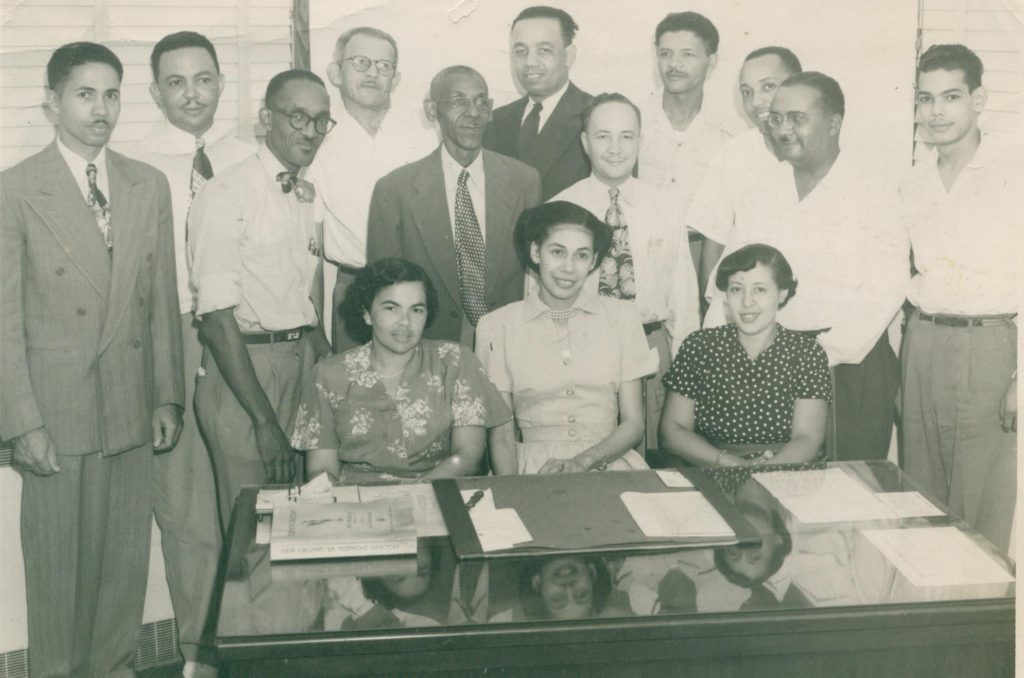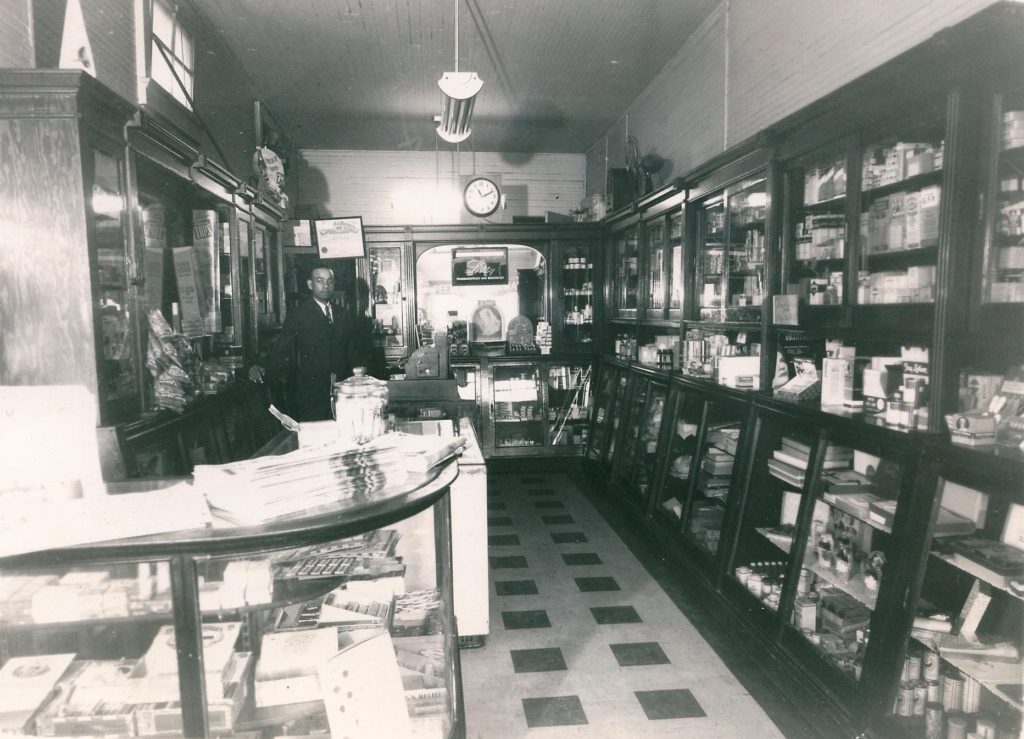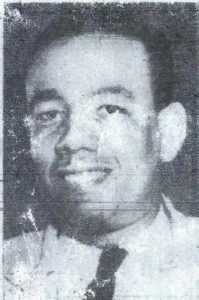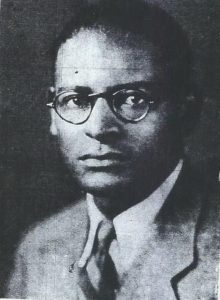Peerless Pharmacy
If you had approached the corner of Thalia and South Dorgenois Streets in the year 1949, you were probably on your way to Peerless Pharmacy. Even though it was located in a very thickly populated Negro section of uptown New Orleans at 3825 Thalia Street, it was patronized by white customers as well. From the time the pharmacy opened in the morning until closing time, people were going in and out buying the many commodities which were stored on the premises.
Its owner, William Henry Parker Jr. became a registered pharmacist in 1934 but desired to have a pharmacy of his own rather than work in someone else’s drug store. With this in mind, he purchased a building that would include his residence as well as space for his future business. He rented out the business portion of the building to someone else and worked as a mail carrier for 11 years in order to accomplish this goal. Eventually, after having saved enough money, he opened his drug store and became the pharmacist himself.
Realizing that his own business needed to grow, he continued his job at the post office while his wife managed the business and another pharmacist was hired to fill prescriptions.
William H. Parker Jr. (1910-1968)
[Pharmacist]
Business boomed and Mr. Parker resigned his mail carrier position and took over his business full-time. He was now able to welcome customers with a broad and friendly smile as they came through his doors. Like all pharmacies, filling prescriptions and selling patent medicines were just two of the many services afforded his customers. Cosmetics, school supplies and magazines also lined store shelves along with an ice cream soda fountain.
With the expansion of the Calliope Project just a short distance away, William Parker was forced (through eminent domain) to sell his property to the government. He really did not want to relocate but had no choice. As a result, his Thalia Street property was torn down and he moved to 3801 Washington Avenue.
For the next 23 years, Mr. Parker could be found from sun up to sun down serving his customers at Peerless Pharmacy. His strong work ethics probably came from his mother who raised 10 children while teaching school and earning a Bachelor’s Degree from Grambling State University.
On June 4, 1968 William Parker suffered a heart attack while at work. He was rushed to the hospital but died just a few hours later. He was only 58 years old.
Mr. Parker was a native of Monroe, Louisiana. He was the oldest of 10 children born to William Parker Sr. and Bertha Medlock Parker. He came to New Orleans in 1931. He attended Meharry Medical School of Pharmacy in Nashville for one year and later completed his studies at Xavier University School of Pharmacy in 1934. His desire to become a pharmacist, according to his family, was nurtured as a young delivery boy while working for a white pharmacist in Monroe, LA who would serve as his role model.
William Henry Parker was married to Grace Clark Parker and had three daughters: Elaine P. Adams, Frances Parker, and Grace P. Velasquez. He was profiled in an article in the 1949 edition of the Louisiana Weekly entitled, ” Know Your Business Community.”
 We believe this is a group of New Orleans Pharmacists who were associates of William H. Parker. Please help us identify those not named below.
We believe this is a group of New Orleans Pharmacists who were associates of William H. Parker. Please help us identify those not named below.
1st Row: [3 women] —————, Cecile Medley (?), —————
2nd Row: Clarence Hill, ————–, ————Landix, Emile LaBranche, ———-, Joseph Zimmerman
3rd Row: Cleveland Peete, —————, William Parker Jr., Henry Julian, Horace Bynum Sr.,
Lawrence C. Chenier Sr. (1906-1952)
[Social Worker]
Lawrence Chenier was born (ca. 1906) and received his early educational training in the parochial schools of Opelousas, Louisiana. He moved to New Orleans, received his high school degree from Xavier Prep and in 1928 was awarded a Bachelor’s degree in Social Work from Xavier University. Upon graduation, he accepted the position of Director of Academics at St. Emma Industrial & Agricultural Institute in Rock Castle, Virginia. It was there that his interest in athletics grew and St. Emma’s sport’s team became a force to be reckoned with.
Upon returning to New Orleans, Lawrence became a field worker in June of 1932 for the Federal Emergency Relief Administration (FERA). FERA was created by President Roosevelt in 1933 with its main goal being to alleviate household unemployment by creating new jobs in local and state governments. By the date of its closure in 1935, FERA had provided jobs for 20 million people throughout the country with a budget of 31.1 billion dollars. After 1935, FERA would be replaced by two entirely new federal agencies, the WPA and Social Security Administration.
Lawrence Chenier’s relentless work efforts at FERA soon earned him a summer fellowship to the Atlanta School of Social Service. On October 20, 1934, he was promoted to the position of Assistant District Secretary of FERA. Often, he and other staff members canvassed the neighborhoods to study the needs and desires of its poor residents. They also opened Crossroads House, a recreational and neighborhood center for poorer blacks who lived in the uptown area.
By 1942, his superiors were so satisfied with his performance and manner of getting along with his clients and co-workers that they promoted him to the position of being named the first Negro Case Worker in the Department of Welfare in New Orleans. His responsibilities encompassed various social aspects of the public assistance program; such as old age assistance, aid to needy blind, aid to dependent children, training for defense jobs, and other war time needs.
In its June 4th, 1949 issue, The Louisiana Weekly featured Mr. Lawrence Chenier as their selection for the title Personality of the Week. As they stated, “We salute Lawrence Chenier because of his unselfish work in social service to the underprivileged and destitute of this community.”
Lawrence C. Chenier passed away November 9, 1952 at the young age of 46. He resided at 1817 Peninston Street and was the beloved husband since 1929 of Mrs. Lydia Victor Chenier. He was the father of 3 children: Lawrence, Ronald and Celine Chenier. Mr. Chenier was involved in many civic organizations and was a member of the American Boys’ Club of America, Lafitte Project Credit Union, Xavier Prep Athletic League, NORD, American Assoc. of Social Workers, Xavier Gold Rush and Alumni Associations.
Sources: The Times-Picayune (obituaries) March 11, 1952 page 2 & June 8, 1968 page 20; The Louisiana Weekly (articles and photos) October 20, 1934 page 1 & June 4, 1949 page 14 & September 1o7, 1942 & April 22, 1936.
A special thank you goes to Elaine Parker Adams (daughter of William Parker Jr.) for the photos she provided of the Peerless Pharmacy and Pharmacy group. She also provided valuable information which is deeply appreciated.
Lolita Villavasso Cherrie






Thank you for this well researched article on two men who were well known names of my childhood.
Clarence Hill is the name of the first pharmacist on the second row.. Sorry, I don’t know any of the rest.
I thoroughly enjoy your articles. They revive good memories of the city of N O. I remember the pharmacy on the corner of Washington Ave and So. Rocheblave which I passed daily on my way to work at James Derham Jr. High two blocks away. Daughter Elaine was just a year behind me at XU and as a fellow librarian and soror, I have observed her many endeavors over the years. The picture reminds me of my brother, John M. Green C’54 whose class of 7-9 had only two female pharmacist. While I do not remember Mr. Chenier, I am familiar with St. Emma’s School in Virginia which I believe was staffed by Sisters of the Blessed Sacrament.
Thank you, Lolita, for the lovely story about my dad. Local neighborhood pharmacists provided many services you cannot get today at the big chain drugstores. Their customers were not wealthy people, so often the pharmacists set up personal credit systems that waited for the individual’s payday. Sunday night was a big event since the church crowd could socialize over ice cream at the soda fountain. On Mardi Gras Day, the Indians would stop at Rose Tavern across the street from Peerless Pharmacy. The tribes were still fighting in those days, so the pharmacist would patch up the wounded.
This was a very well-researched and very interesting article. Thanks for sharing the information. I only have one correction. That’s my grandfather in the third row picture and his name is listed as Henry Bynum. His name is Horace Bynum senior.
Thanks for keeping these stories alive Lolita. As always, well researched and well written.
The person at the right end of the second row is my cousin Joseph Zimmerman. I am pretty sure. As you will see I am a Parker also. My full name is William H. Parker Jr. I went to school at Xavier Prep. My father Williams H. Parker Sr. taught at Xavier Prep until 1956, my first year there. At that time he entered the Public School System. He passed away in 1988. He would have known every one in this picture.
Lawrence Chenier was my uncle. He was married to my mother’s sister, Lydia Victor Chenier. My mother was Jeanne Victor Labat. My father was Victor Labat, Chairman of Industrial Arts, XULA & First Director of Alumni Affairs, XULA. Great article on Lawrence Chenier who was also well known as a football referee at high school & college games. His son, Ronnie was quarterback for XULA, LARRY Chenier Jr. was a Postal worker and daughter Celine was a social worker (not sure). Mr. Horace Bynum Sr. gave me my first job as a Pharmacist in 1963.
I believe the second woman in the picture of pharmacists is Cecile Medley. Not sure, but if not, the resemblance is uncanny.
The second woman in the picture is Cecile Medley. She has a copy of this picture and is in Lafon Catholic Nursing home with a very good memory at about 91 years old (young).
Another great job! I was especially happy to see Mr. Julien in the picture. He was the father of my dear friend, Janet Julien Brown and a person who was very dear to me.